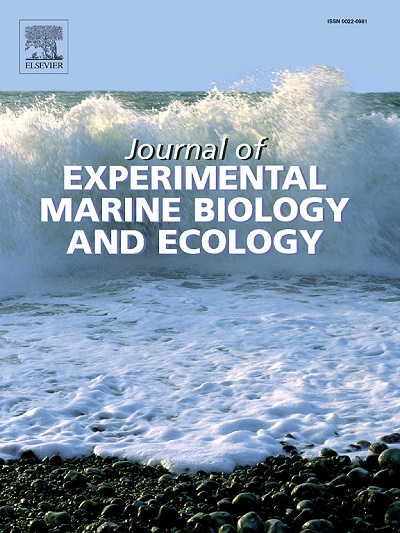Red mangrove (Rhizophora mangle) roots serve as additional valuable habitat for the eastern oyster (Crassostrea virginica) in a subtropical estuary
IF 1.8
3区 生物学
Q3 ECOLOGY
Journal of Experimental Marine Biology and Ecology
Pub Date : 2025-02-01
DOI:10.1016/j.jembe.2025.152083
引用次数: 0
Abstract
Occasionally, two foundation species co-exist within seascapes, where one is nested within, or near, the other. However, we often lack an understanding of interactions between co-existing foundation species and how such interactions may affect their demographic rates. Oysters and mangroves are foundation species that often co-occur in subtropical estuaries, with oysters assembled into reefs found near mangrove-rimmed shorelines or oysters growing attached to mangrove prop roots. We evaluated demographics and potential ecological mechanisms affecting eastern oysters (Crassostrea virginica) living on intertidal reefs compared with those growing on red mangrove roots (Rhizophora mangle) using a series of field surveys and by measuring evaporation rates as proxy for desiccation. We found that total oyster density on mangrove roots was over two times higher per unit sample area compared to intertidal reefs. This difference occurred despite slightly higher oyster settlement rates to reefs than mangrove roots, suggesting higher post-settlement mortality in reefs compared to roots. Higher oyster mortality on reefs was consistent with our observations of more predators, higher percentage of gaping oysters, and greater abiotic stress on oysters on reefs versus mangrove root habitats. The comparative demography of oysters on reefs and mangrove roots provides insight into mechanisms by which mangrove roots represent valuable habitats for eastern oysters. Moreover, these findings suggest that future oyster restoration efforts may benefit by considering restoring oyster reefs in close proximity to red mangroves given their additional source of potential oyster settlers.

红树(Rhizophora mangle)的根在亚热带河口为东牡蛎(Crassostrea virginica)提供了额外的宝贵栖息地
偶尔,两种基础物种在海景中共存,其中一种在另一种内部或附近筑巢。然而,我们经常缺乏对共存基础物种之间相互作用的理解,以及这种相互作用如何影响它们的人口统计率。牡蛎和红树林是亚热带河口经常共存的基础物种,牡蛎聚集在红树林边缘海岸线附近的珊瑚礁中,牡蛎附着在红树林的支柱根上生长。通过一系列实地调查和测量蒸发率作为干燥的代表,我们评估了生活在潮间带珊瑚礁上的东方牡蛎(Crassostrea virginica)与生长在红树根部(Rhizophora mangle)上的东方牡蛎(Crassostrea virginica)的人口统计学和潜在生态机制。我们发现,与潮间带珊瑚礁相比,红树林根部的牡蛎总密度每单位样本面积高出两倍以上。尽管牡蛎在珊瑚礁上的定居率略高于红树林根系,但这种差异仍然存在,这表明与根系相比,珊瑚礁在定居后的死亡率更高。礁石上牡蛎的死亡率较高,这与我们观察到的更多捕食者、更高比例的开口牡蛎、以及礁石上牡蛎比红树林根部栖息地更大的非生物压力是一致的。牡蛎在珊瑚礁和红树林根部的比较人口学提供了对红树林根部代表东部牡蛎宝贵栖息地的机制的深入了解。此外,这些发现表明,考虑到红红树林附近的牡蛎礁有额外的潜在牡蛎定居者来源,未来的牡蛎恢复工作可能会受益。
本文章由计算机程序翻译,如有差异,请以英文原文为准。
求助全文
约1分钟内获得全文
求助全文
来源期刊
CiteScore
4.30
自引率
0.00%
发文量
98
审稿时长
14 weeks
期刊介绍:
The Journal of Experimental Marine Biology and Ecology provides a forum for experimental ecological research on marine organisms in relation to their environment. Topic areas include studies that focus on biochemistry, physiology, behavior, genetics, and ecological theory. The main emphasis of the Journal lies in hypothesis driven experimental work, both from the laboratory and the field. Natural experiments or descriptive studies that elucidate fundamental ecological processes are welcome. Submissions should have a broad ecological framework beyond the specific study organism or geographic region.
Short communications that highlight emerging issues and exciting discoveries within five printed pages will receive a rapid turnaround. Papers describing important new analytical, computational, experimental and theoretical techniques and methods are encouraged and will be highlighted as Methodological Advances. We welcome proposals for Review Papers synthesizing a specific field within marine ecology. Finally, the journal aims to publish Special Issues at regular intervals synthesizing a particular field of marine science. All printed papers undergo a peer review process before being accepted and will receive a first decision within three months.

 求助内容:
求助内容: 应助结果提醒方式:
应助结果提醒方式:


